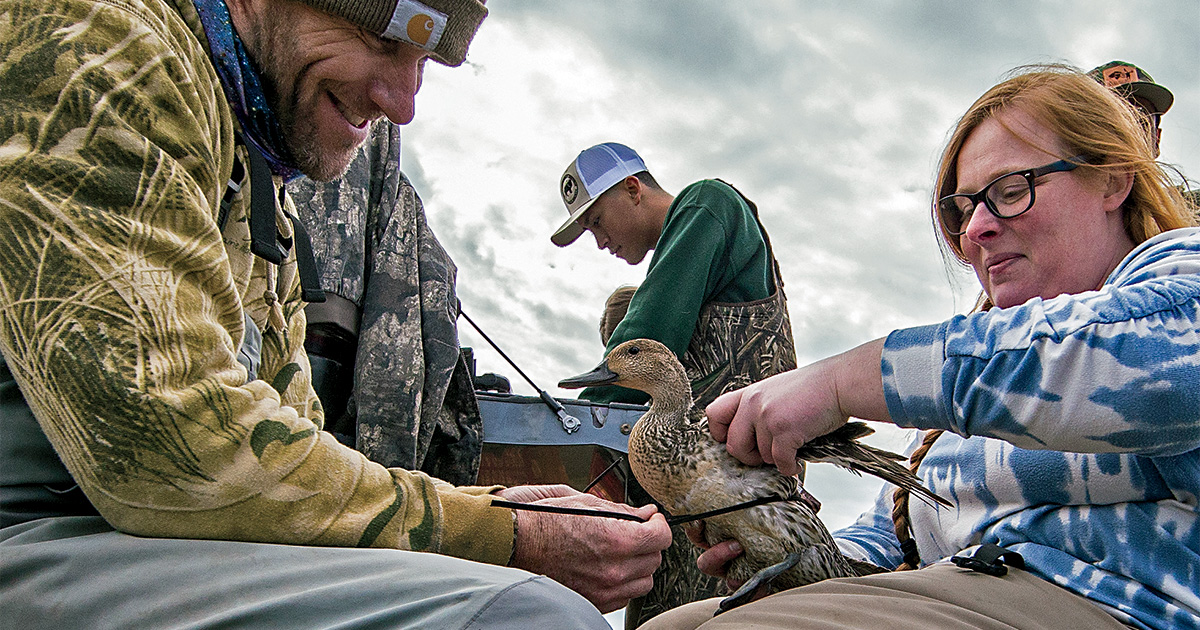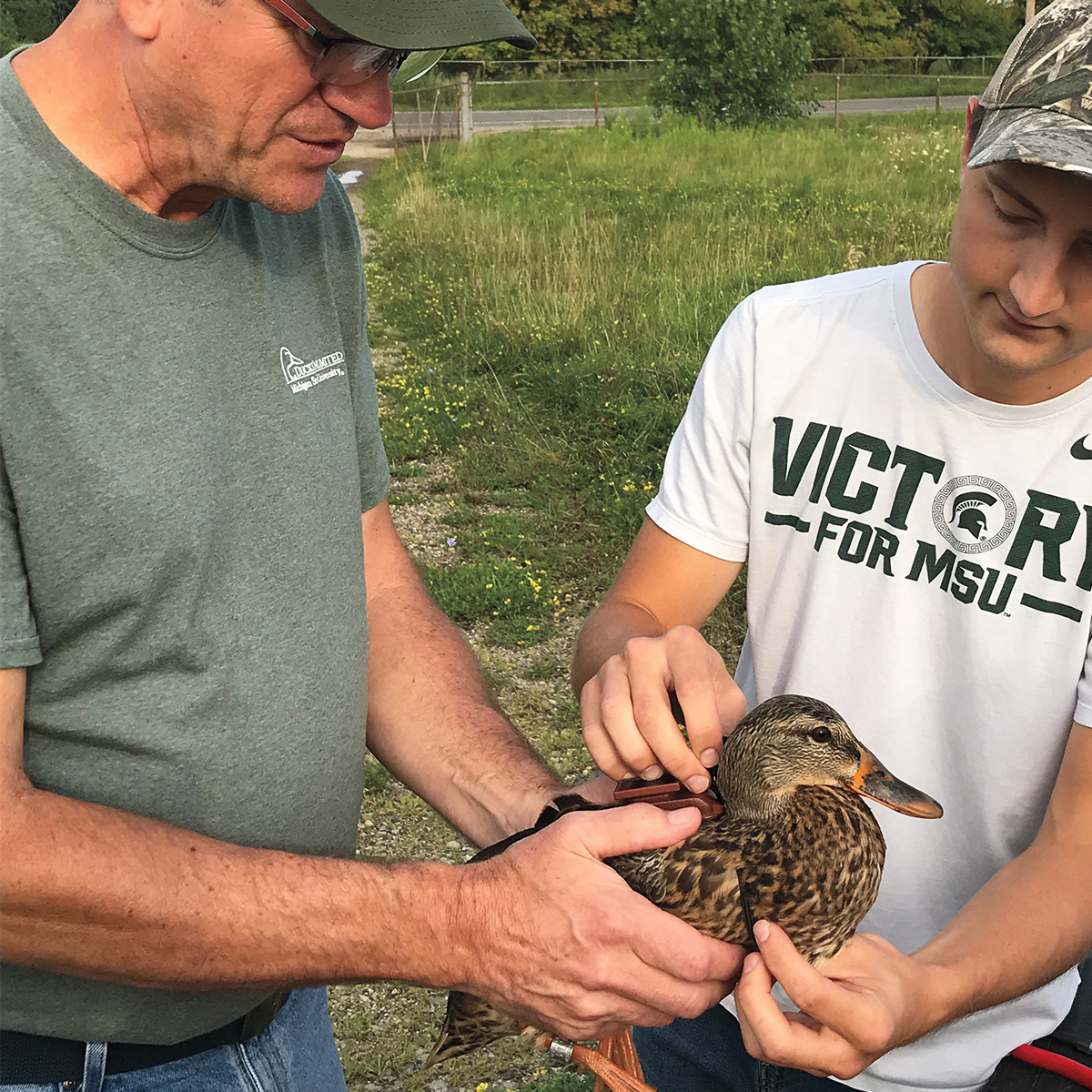Understanding Waterfowl: Mobile Duck Data
Scientists are relying on cell phone technology to better understand waterfowl migration and habitat use
Scientists are relying on cell phone technology to better understand waterfowl migration and habitat use
By Joe Genzel

Researchers attach a solar-powered telemetry device to a hen northern pintail. These devices transmit location data to nearby cell phone towers, allowing scientists to track the movements of waterfowl remotely over great distances.
Waterfowl telemetry studies are not especially new, but the technology supporting the latest research certainly is. Not so long ago, biologists used battery-powered radio transmitters to track the movements of birds. To receive and plot location data, researchers had to be within a relatively short range of the marked birds, where they could receive signals emitted by the transmitters. This required them to physically follow the birds, often in vehicles mounted with giant antennae. It was time-consuming and inefficient, and the transmitter batteries eventually ran out of juice.
Today, most tracking devices are solar-powered, capable of collecting GPS-quality locations, and automatically transmit data to the nearest cell phone tower. This allows researchers to conveniently monitor marked birds remotely with a computer via the internet. And if a hen mallard travels out of cell range, the transmitter stores the data until she flies near the next tower. The data points are documented so biologists can track the birds’ migration, local movements, and fine-scale habitat use. There is also an accelerometer built into most telemetry units, which can be used to determine if birds are feeding, resting, flying, and nesting.
“These studies produce millions of data points that not only help us better understand waterfowl movements, but we can also see where the birds are spending the majority of their time and what they are doing throughout the year,” says Kelly Warren, a DU regional biologist in Oregon. “That allows us to focus our habitat conservation efforts in specific areas to benefit certain species.”
Warren is one of several partners conducting a telemetry study of lesser Canada geese and Taverner’s cackling geese (two subspecies of white-cheeked geese) that is being coordinated by Alaska’s Department of Fish and Game. The five-year project, which is now in its first year, focuses on the annual movements and distribution of each subspecies. Very little is known about the wintering habitat needs of either population, both of which breed mainly in Alaska.
“Here in the Pacific Flyway, we have seven subspecies of Canada and cackling geese. The last studies conducted on Taverner’s or lessers took place in the 1980s, so this research will be exciting and beneficial to see what we find out and how it can inform our habitat work,” Warren says.
Pintail populations have been trending in the wrong direction since the 1980s. According to the 2022 Waterfowl Breeding Population and Habitat Survey, sprig numbers fell 21 percent from the last count in 2019 (the survey was suspended for two years due to the pandemic). The population, estimated at 1.78 million birds, was also 54 percent below the long-term average.
Dr. Bart Ballard and PhD student Georgina Eccles at Texas A&M−Kingsville, along with many collaborators, have spent the last three years tracking hen pintails that were marked with telemetry devices on wintering areas from California to Louisiana. Hen pintails rely on stored nutrient reserves, which are accumulated on spring migration stopovers, to aid in producing eggs when they return to the breeding grounds. A better understanding of the birds’ migration strategies and where they acquire these reserves could help guide targeted habitat conservation work to benefit pintails.
“The recent advancement of tracking device technology has changed the game for waterfowl researchers,” Ballard says. “We have automated devices that transmit data through satellites or cell towers. These devices last more than a year and can collect extremely accurate location information at frequent intervals. This enables us to investigate the entire annual cycle of such a highly mobile species as the pintail and helps inform habitat management to a much greater level.”

DU scientist Dr. John Coluccy and PhD student Ben Luukkonen prepare to release a bird equipped with a transmitter as part of a major study on Great Lakes mallard populations.
Over the past 20 years, the mallard breeding population in the Great Lakes region has been declining. A study being supported by DU and several partners aims to find out why. To learn more about the birds’ movements and habitat preferences, researchers outfitted nearly 500 hen mallards with transmitters over the last three years across Wisconsin, Michigan, Ohio, Illinois, and Indiana. Most of these birds have remained in the region, even during the depths of winter.
Genotype is also being documented as part of research being conducted by Ben Luukkonen, a PhD student at Michigan State University. As part of this research project, biologists captured mallards in urban and rural areas. Blood samples taken from birds in 2021 revealed that 59 percent of the hens were not wild birds, but hybrids produced by interbreeding between wild mallards and released game farm birds. The percentage was even higher in urban mallards—78 percent were hybrids. Determining whether there are differences in migration and habitat use between these genetically unique groups of mallards is an intriguing project that could have implications for conservation planning in the future.
“The Great Lakes mallard study is in its final year, but there will be one or two more years of data analysis before we fully understand what’s going on with these birds,” says Dr. John Coluccy, director of conservation planning in DU’s Great Lakes/Atlantic Region. “Game-farm mallard hybridization is also prevalent in eastern mallards, and ongoing research is exploring the pervasiveness of this phenomenon in the midcontinent.”
From 1966 to 2014, the American black duck population suffered an 84 percent decline. The population has since stabilized, but the drop in black duck numbers prompted conservationists to take a hard look at Atlantic Flyway staging and wintering habitats used by the birds. They discovered that the salt marshes that black ducks depend on during the nonbreeding period have been severely degraded. Only 3.1 million acres of salt marsh remain along the Atlantic Coast. As a result, DU and its partners have expanded their efforts to restore these highly productive wetlands to benefit black ducks and an abundance of other migratory birds as well as fisheries.
Now researchers have turned their attention to black duck breeding areas. “A majority of the black duck studies have taken place along migration routes, but no one has really looked at the breeding grounds in the Eastern Boreal Forest because it’s such a difficult place to work,” says Dr. Mitch Weegman, DU Canada Endowed Chair in Wetland and Waterfowl Conservation at the University of Saskatchewan.
Over the next three years, 450 telemetry units will be deployed on black ducks on important wintering areas. With key support provided by the Black Duck Joint Venture, the birds will be tracked by PhD student llsa Griebel to monitor their movements and habitat use on the breeding grounds. “The whole purpose of this study is to understand what the ducks are doing in the summer, but also, if possible, to link those sensitive salt marsh habitats used by the birds in winter and during migration to reproductive outcomes,” Weegman says. “Then the idea is to holistically guide conservation plans with knowledge of which part of the annual cycle contributes most to black duck reproductive success.”
As these studies clearly illustrate, cutting-edge telemetry research is taking the guesswork out of waterfowl habitat delivery. Thanks to advances in transmitter technology and the network of cell towers across the continent, we can see exactly where ducks and geese spend most of their time. That information can then be used to protect and restore wetland habitat where the birds need it most.
Ducks Unlimited uses cookies to enhance your browsing experience, optimize site functionality, analyze traffic, and deliver personalized advertising through third parties. By continuing to use this site, you agree to our use of cookies. View Privacy Policy